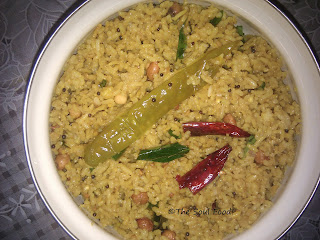200 gms Raw Rice
50 gms Tamarind
1/2 Tbsp Grated Jaggery or Bellam
1 Tbsp Turmeric Power
3 Green Chillies (Slit long side)
1 Tbsp Cooking Oil
1/2 Tsp Mustard Oil
Salt to taste
For Seasoning:
4 Tbsp Sanaga Pappu or Chana Dal
2 Tbsp Minnappau or Urad Dal
Few Peanuts or Cashwenuts
1 Tsp Mustard Seeds or Aavalu
1/2 Tsp Ingua or Hing or Asafoetida
3 Red Dry Chillies
2 Tbsp Coriander Powder (optional)
3 Tbsp Cooking Oil
10-12 Curry leaves
Process:
1. Rinse Raw Rice. Add two measures of water of water and 2-3 drops of cooking oil. Pressure cook until 3 whistles. Once the steam escapes transfer the rice into a wide plate.
2. Add 1/2 tablespoon of Turmeric Power and 1 tablespoon of Cooking oil and a few Curry leaves. Keep it aside.
3. Prepare Tamarind Pulp as follows:
(i) Wash Tamarind superfluously and soak it in a hot water for 10 mins.
(ii) Once cooled extract the pulp. Keep it aside.
(iii) Heat a thick bottom kadai, add 3 of Cooking oil. When hot add slit Green Chillies and extracted Tamarind Pulp.
(iv) Add Salt to taste, Turmeric powder and grated Jaggery (Bellam) and allow it to boil.
(v) When cooked, you will notice oil on the walls of the kadai, this indicates that the Tamarind pulp is ready.
 |
| Cooked Tamarind Pulp |
For Seasoning:
1. Soak Chana dal or Sanaga pappu for 2 hours. When soft drain the water completely and keep it aside.
 |
| Soaked Chana Dal |
2. Heat two tablespoons of cooking oil in a Kadai. Add drained Chana dal or Sanagapappu and fry it till golden brown. Transfer it into a small dish and keep it aside.
3. In the same oil add Urad dal and fry it for a min. Add mustard seeds, red chillies and Ingua (hing or asafoetida) and fry them till the crackling sound of the mustard seeds come to an end. Now add a few curry leaves and transfer the whole thing onto the rice.
4. In the same kadai, add another soon of Cooking Oil and add Cashwenuts or Peanuts. Fry them till golden brown and transfer this into the fried Chana dal dish.
5. Now add fried Chana dal and Cashwenuts or Peanuts along with the rice. At the end, add Coriander powder and half a tea spoon of Mustard oil. Mix it well.
 |
| Yummy Traditional Pulihora is Ready to be served :) |
Note: The quantities of tamarind pulp and salt may vary from individual to individual depending upon their personal taste.
Happy Cooking!!
Your Favorite Chef!







